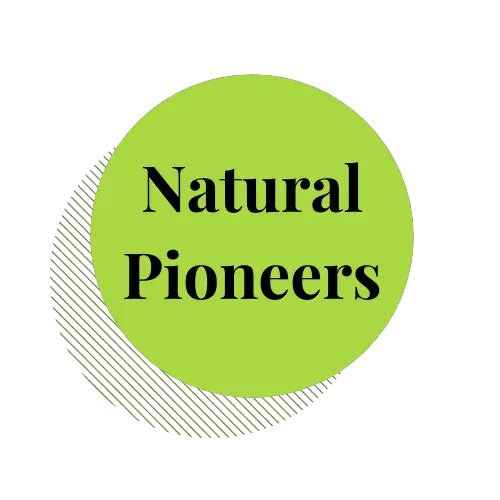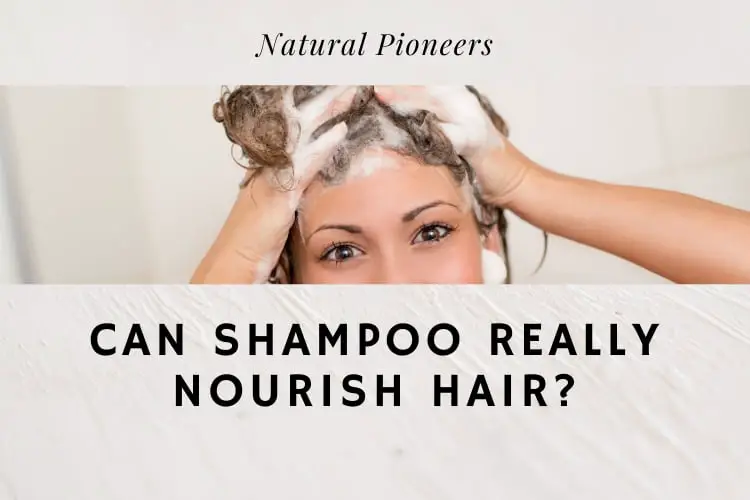
We all use shampoo on a regular basis. So how come we know so little about how it works and what it can really do for our hair? Let’s explore how shampoo works, what it can and cannot do, what the ideal shampoo looks like and the brands that meet this ideal.
Shampoo can nurture our hair as it provides substances necessary for a good condition. Dry hair & damaged hair shampoos are the most nourishing. They provide mild cleansing and good conditioning to protect hair, minimize frizz & add shine. The ideal shampoo is nurturing, non-toxic, and pH balanced.
Let’s explore what nourishing means and how a good shampoo can do the job.
1. Is Shampoo Nourishing?
Let’s make sure we have a common understanding of the term “nourishing”.
According to the Oxford Dictionary, ‘to nourish’ means ‘provide with the food or other substances necessary for growth, health, and good condition’.
Now that we know what “to nourish” means, let’s find out if shampoo contains ingredients that help our hair:
- Grow,
- Be Healthy,
- And Be In Good Condition
1. Can Shampoo Make Hair Grow?
All shampoo formulations contain the same basic ingredients. While the variety of shampoos in the marketplace seems confusing, the ingredient categories are to a large extent standard.
Let’s see what’s inside that could potentially help make our hair grow faster.
Shampoo Formulation
- Synthetic Detergents: Remove dirt, styling products, sebum, and skin scales from hair and scalp
- Conditioners: Leave the hair soft and smooth
- Sequestering Agents: Prevent soap scum from forming on the hair
- Preservatives: Prevent microbial and fungal contamination of shampoo
- Specialty Additives: Provide ingredients for special treatment (for example dandruff)
- Foaming Agents: Suds have only one function, to satisfy people’s need for foamy products and have no cleaning power in themselves
- Thickeners: Thicken the shampoo, as people feel that a thick shampoo works better
- Opacifiers: Added to make a shampoo opaque for aesthetic purposes
- Fragrances: Added to give the shampoo a desired smell [1]
When we take a close look at the formulation list, we recognize that almost half the ingredients are not required. Foaming agents, thickeners, opacifiers, and fragrances are nice to have, but have no impact on a shampoo’s true effectiveness.
As far as hair growth is concerned, we could find them in specialty additives (special ingredients for hair growth) as detergents, conditioners, sequestering agents, and preservatives do not impact on hair growth.
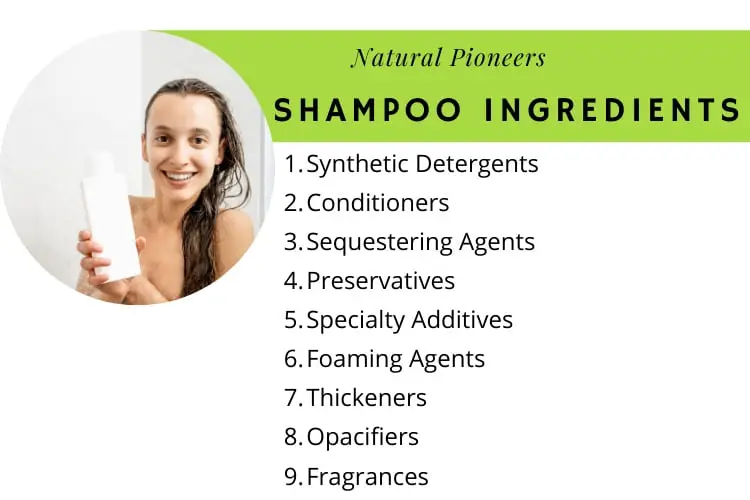
So, is there a specialty additive in shampoos that can make our hair grow faster? Generally, if it did exist, you’d need to look for a shampoo that claims to enhance hair growth. Normal shampoos do not contain specialty additives that promote hair growth.
With that being said, there are some chemicals that have an impact on hair growth. Finasteride (Propecia®) and Minoxidil (Rogaine®) are two popular chemicals that seem to work for some people. Especially men with hair loss are among Finasteride’s and Minoxidil’s customers.
A word of caution: These chemicals are associated with sexual dysfunction. In men, 94% developed low libido, and 92% developed erectile dysfunction. [2]
We’ll talk more about chemicals in shampoos in the following chapters.
The Take-Away: Regular shampoo does not make hair grow faster, nor does it help with thinning hair or balding. Chemicals in specialty shampoos are highly toxic and come with persistent adverse health effects.
>>Read more: Is Natural Hand Soap Antibacterial?
2. Can Shampoo Make Hair Healthier?
According to research, shine and volume are the essential components for what we refer to as “healthy” hair. [3]
While hair texture and shine relate to hair surface properties, it’s the integrity of the hair cuticle (outer layer) and hair cortex that tell us in what shape our hair really is. The cuticle is the outermost layer of our hair. It is a hard, shingle-like layer of overlapping cells.
When the cuticle is damaged through heat, products, or treatments, our cortex is in great danger. The cortex of the hair shaft is the thickest hair layer. It also contains most of the hair’s pigment, giving the hair its color, strength, and moisture. [4] When the damage goes as far as to reach the cortex, our hair strands become weak and vulnerable to breaking and splitting.
Healthy hair has a sealed cuticle layer which provides ideal protection to the cortex. This allows your hair to keep its natural strength, moisture, and hair pigment.
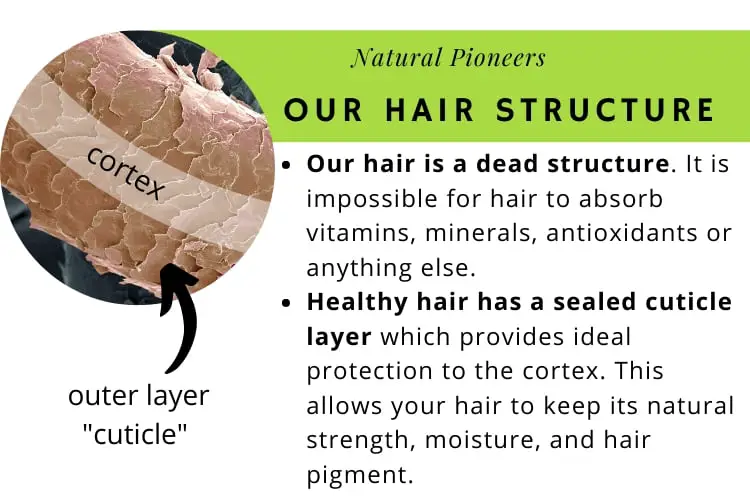
Our hair shaft, that is our visible hair, is a dead structure. [5], [6] Therefore, it is impossible for hair to absorb nutrients from shampoo. Studies show, that if you use a shampoo formulation that is not suited for your hair type, this can increase friction between the fibers and may lead to cuticle damage and breakage. [7]
In the next chapters, we’ll go over what shampoo works best for your hair type.
The Take-Away: Our hair is a dead structure. It cannot absorb nutrients from shampoo. Shampoo cannot repair damaged hair nor can it make hair healthier.
>>Read more: Is Natural Shampoo Really Better?
3. Can Shampoo Put Hair In A Good Condition?
To answer this question, we need to know what exactly a good condition is. If we ask researchers that question, they will tell you that they are looking for 8 functions in a shampoo. When a formulation can achieve those 8 functions, this will leave hair in a so called “good condition”.
The 8 features, shampoo manufacturers are trying to achieve:
1. To clean the hair and scalp.
2. To remove any previously applied hair products.
3. To deliver an optimum level of foam.
4. To make combing hair easier (conditioning)
5. To provide hair and scalp with active ingredients (for example to treat psoriasis).
6. To be non-toxic and non-irritating to hair and scalp.
7. To be non-damaging to the eye.
8. To prevent static charge build-up. [8]
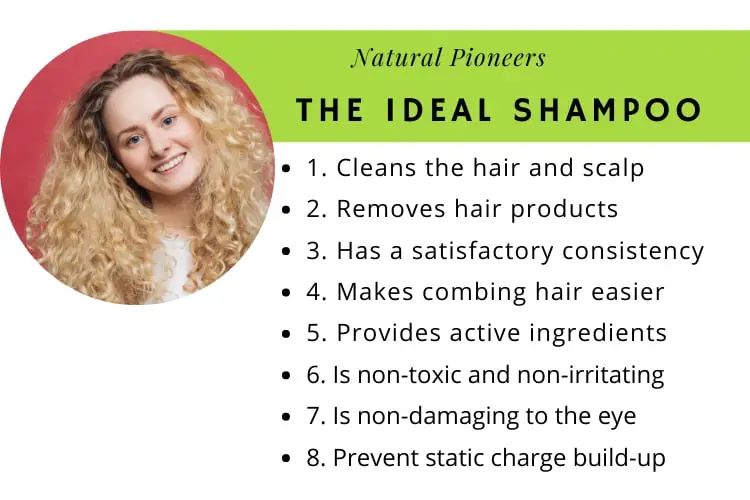
To meet most of these requirements, shampoos are typically composed of 10–30 ingredients. [9]
The main features relevant to a good condition besides cleaning properties, are a shampoo’s conditioning abilities as well as the prevention of static charge. Let’s see how a shampoo can achieve this.
Let’s dive into (easy to understand) physics to see how these two mechanisms work.
When we wash our hair, our hair has a negative charge. Think of the negative pole of a magnet. Shampoos contain a small amount of conditioners which are positively charged. That means they are strongly attracted to our hair and evenly stick to it.
This electrostatic interaction lubricates the surface of each hair follicle and makes combing a lot easier. Since the negative charge (-) after shampooing and the positive conditioning charge (+) balance each other out, this also helps reduce frizz. [10]
The pH Of Shampoo
An additional factor, many people don’t know about, is the importance of the pH of a shampoo. The pH is a scale used to specify how acidic or basic something is. Anything between 0 and 6.9 is acidic, 7 is neutral and anything between 7.1 and 14 is considered alkaline. The pH of hair is between 4.5 and 5.0, so is the oil on our scalp. [11]
With this natural acidity of hair and scalp, our skin remains healthy and prevents fungi and bacteria from growing. But it also affects our cuticle. An alkaline pH leaves the cuticle closed and healthy. Therefore, if a shampoo has an alkaline pH, this increases friction between the fibers and can lead to cuticle damage and breakage. [12]
Shampoo with a pH ≤ 5.0 is ideal for healthy scalp and hair.
Interestingly, studies show that only 38% of popular brand shampoos have an ideal pH. Since this topic is not commonly known and asked for by consumers, very few shampoo brands reveal the pH of their product. We’ve got you covered and have researched pH-balanced brands that we’ll share at the end of this article.
The Take-Away: Shampoo can leave our hair in a good condition. Most shampoos contain a small amount of conditioner. This lubricates the surface, makes combing easier, and reduces frizz. An ideal formulation has a pH of less than 5.0 which supports the natural and healthy pH of scalp and hair.
Still with me?
We now know that shampoo can indeed nurture our hair. While it cannot make it grow faster or healthier, it can put it in a good condition which corresponds to the definition of nurture.
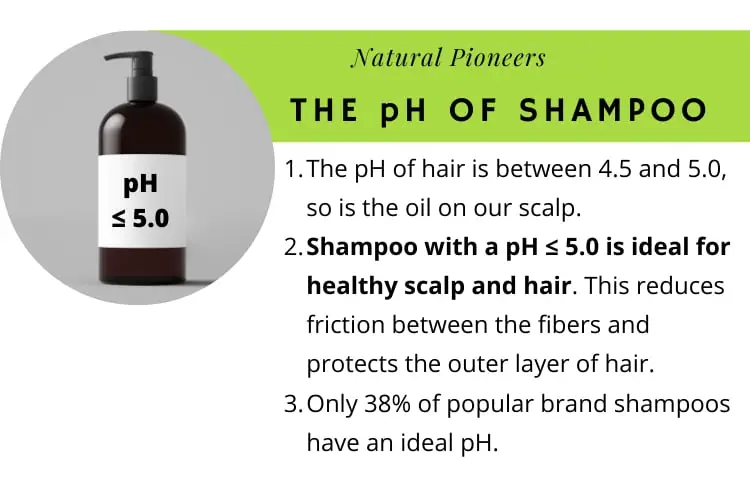
Now it’s time to look into available shampoo brands. Let’s learn about what shampoo types work for what types of hair and the toxins we should avoid.
Conclusion: Shampoo can nurture our hair. According to the Oxford Dictionary, ‘to nourish’ means ‘provide with the food or other substances necessary for growth, health, and good condition’. While shampoo cannot make hair grow or make it healthier, it can put it in good condition. Most shampoos contain a small amount of conditioner. This lubricates the surface, makes combing easier, and reduces frizz. An ideal formulation has a pH of less than 5.0 which supports the natural and healthy pH of scalp and hair.
2. What Shampoo Is Most Nourishing?
As we’ve revealed in the first chapter, nourishing refers to shampoos ability to put hair in a good condition. Next to it’s cleansing action, the amount of conditioner in shampoo as well as its pH are the two main qualities we’re looking for.
Before we dive into shampoo brands, let’s learn about basic formulations of shampoos to understand what types of shampoo work for what hair type and how nourishing they are.
Normal Hair Shampoo
It Is Designed For: People with normal hair. That means hair that is not colored or chemically processed. Most men fall into this category. [13]
Is It Nourishing? Normal hair shampoo is on the harsher side, focus on removing oil and provide only minimal conditioning. [14]
Nourishing Score: 2/5
Dry Hair & Damaged Hair Shampoo
It Is Designed For: People with dry, damaged, frizzy, and dull hair. Be careful, many shampoos for dry hair contain microplastics and chemicals that can harm our health. [15]
Is It Nourishing? Dry hair shampoos provide mild cleansing and good conditioning. [16]
Nourishing Score: 5/5
Oily Hair Shampoo
It Is Designed For: People with very oily skin. Oily hair shampoos are designed to deeply clean your scalp and hair shaft. Be careful, overusing these harsh shampoos can damage your hair as well as promote even more oil production. [17]
Is It Nourishing? These shampoos contain strong detergents and make minimal use of conditioners. [18]
Nourishing Score: 1/5
Everyday Shampoo
It Is Designed For: People who want to wash their hair daily. Some people feel that they do not have good hygiene unless they bathe daily. Be careful, using shampoo on a daily basis is not recommended since it is more damaging to the hair shaft than beneficial. It can dry out your skin and damage your hair. [19]
Is It Nourishing? These shampoos contain mild detergents and do not incorporate conditioners. [20]
Nourishing Score: 1/5
>> Read more: The Quick And Easy Guide To Bath Salts
Deep Cleaning Shampoo
It Is Designed For: People with lots of styling product in their hair. Deep cleaning shampoos are also known as clarifying shampoos. They are designed to thoroughly remove built-up styling products. These shampoos are typically used once weekly to keep the hair free of hair styling product build-up. [21]
Is It Nourishing? Deep cleaning shampoos use a strong detergent and with no conditioners. [22]
Nourishing Score: 0/5
Baby Shampoo
It Is Designed For: Babies, children, and people who prefer tear-free shampoos. Baby shampoos are non-irritating to the eyes. The detergent acts as an anesthetic and numbs the eye tissues to prevent stinging. Thus, eye damage can still occur if the baby shampoo is accidentally introduced into the eye, but the injury is not painful. [23]
Is It Nourishing? Baby shampoos are designed with mild cleansing agents and small amounts of conditioners. [24]
Nourishing Score: 2/5
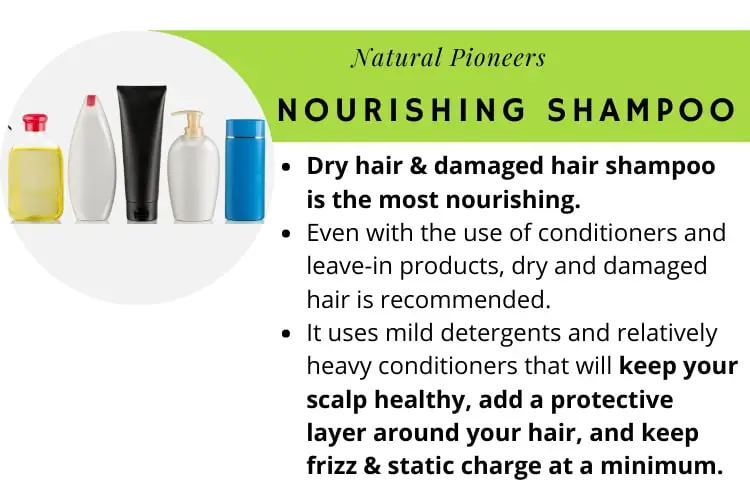
What about professional shampoo available in hair salons? Research shows, that there are no ingredients in salon shampoos that you can’t find in regular shampoo products. Hence, unless your stylist recommends an acidic shampoo after a treatment to restore the irritated outer layer (cuticle) of your hair, regular shampoo is just as good. [25]
Do I need a nourishing shampoo if I use a conditioning product after each wash? Regardless of whether you use a conditioner that needs to rinsed out or a leave-in product after you use shampoo, we still recommend nourishing shampoo. That is because nourishing shampoo will use mild detergents and relatively heavy conditioners that will keep your scalp healthy, add a protective layer around the outer layer of your hair (cuticle), and keep frizz as well as static charge at a minimum.
Shampooing is like polishing leather. But, just like polishing shoes, this layer is temporary.
Dr. Jetske Ultee, Research Physician in Cosmetic Dermatology
The Take-Away: Dry hair & damaged hair shampoo is the most nourishing. It provides mild cleansing and good conditioning to protect hair, minimize frizz and add shine.
If you’re about to head to the store for a dry or damaged hair shampoo – stop! Before we give you our recommendations for products, let’s have a word about chemicals and toxins in our shampoos.
3. Toxins In Shampoo
It has been said that the advertising, package, fragrance and color sell the first bottle of shampoo and the performance of the product sells the second bottle. [26]
However, with the aim to sell that second bottle, large corporations have increased the toxic load in their shampoos. Especially the US market is heavily impacted by that. As a comparison, the US bans 11 ingredients from shampoos, Canada bans 587, and the EU bans 1328. [27]
Let’s see what toxins are found in most shampoos in the US and how they affect our health based on studies.
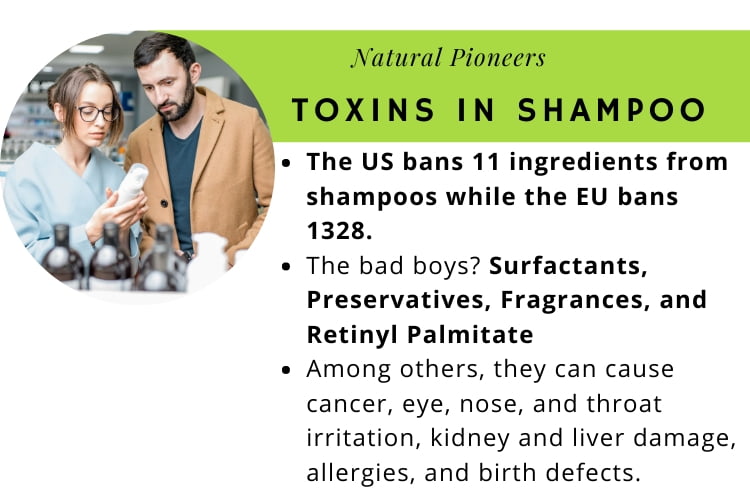
1. Surfactants
Surfactants increase a shampoo’s spreading properties allowing it to penetrate our hair evenly. Some produce bubbles, that we all enjoy while shampooing our hair. During production 1,4-dioxane is formed which is known to cause cancer. It is banned from use in the European Union. Short-term exposure may cause eye, nose, and throat irritation, long-term exposure may cause kidney and liver damage. [28], [29]
The Bad Boys: sodium lauryl sulfate (SLS), sodium laureth sulfate (SLES), cocamidopropyl betaine, and cocamide DEA. Non-toxic, safe surfactants include decyl glucoside and laurel glucoside.
The Take-Away: Use sulfate-free shampoo.
2. Preservatives
To extend shelf life, many shampoos contain preservatives. Some may cause breast cancer, are associated with immunotoxicity and allergies, or are neurotoxins. [30], [31], [32]
The Bad Boys: Parabens, benzyl alcohol, methylisothiazolinone, and methylchloroisothiazonlinone.
The Take-Away: Avoid these at all cost and check out our list of safe, non-toxic shampoos at the end of this article.
3. Smells
When you see “fragrance” or “parfum” on the ingredients list, they really mean phthaltes. Phthaltes disrupt our hormones and can harm our reproductive system. In children, they can disturb normal development. [33], [34], [35]
The Bad Boys: Phthaltes (labeled as parfum or fragrance).
The Take-Away: Go fragrance free or choose essential oils.
4. Retinyl Palmitate
Retinyl palmitate is a form of Vitamin A. It is associated with birth defects and a known carcinogen, causing an increase in skin tumors.
The Bad Boys: Retinyl palmitate.
The Take-Away: Avoid retinyl palmitate at all cost and check out our list of safe, non-toxic shampoos at the end of this article. [36], [37]
>> Read more: What Is Natural Dish Soap?
I want to invite you to check all your personal care products at the EWG Skindeep Database to see how safe they are. You can find the link here. I remember the day when I cleared-out our house from all products that didn’t meet my safety-standard. It was the best feeling and I still feel so good about the products that my family uses.
Let’s now take a look at ideal shampoos that meet all of our requirements.
4. Best Toxin-free & Nourishing Shampoos

Here are our favorites. These products meet all of our requirements. That is, they:
- Nourish our hair
- Are safe and non-toxic
- Are pH balanced to keep hair and scalp healthy
My family and I We switch between these brands. They are safe, trusted, and personally tested.
1. Herbal Essences bio:renew Aloe & Hemp Sulfate Free
Why We Love It:
- Nourishing dry hair & great frizz control
- EWG Certified
- pH-balanced and color safe
- Made with real botanicals
2. Boyzz Only No Nonsense Shampoo
Why We Love It:
- Essential oils for fragrance
- Gentle high concentrated plant based cleansing
- Boys love it!
- EWG Certified
3. Bubble & Bee Peppermint & Tea Tree Shampoo
Why We Love It:
- No synthetic detergents, just gentle natural soap
- Vegan & no animal testing
Note: This product is a little bit different to use. Your order comes with one 8 oz bottle of Peppermint & Tea Tree Shampoo, one 16 oz rinsing bottle, and full instructions and information.
4. Attitude Super Leaves Nourishing & Strengthening
Why We Like It:
- Great smell & a staple in our house!
- pH balanced & EWG Certified
- Bulk refills keep you stocked and reduce plastic waste
- Buy a product & plant a tree!
5. Be Green DRY Shampoo
Why We Like It:
- EWG certified
- With organic ingredients such as arrowroot and kaolin clay
- This dry shampoo is ideal for busy people or when traveling or camping
Whatever product you choose, keep in mind that shampoo cannot repair damaged hair but merely protect it, add shine, and minimize frizz and static charge. [38] In order to keep your hair as healthy as possible, minimize heat exposure (sun, straightening iron, blow-dryer, …) and use a simple haircare routine including shampoo, conditioner, and perhaps hair masks or leave-in conditioner.
Eating a healthy diet with plenty essential fatty acids and vitamins is essential as well as eliminating all hair products that contain toxic chemicals. [39], [40] The recommendations we provided ensure your using safe, non-toxic products that effectively clean and protect your hair. For smooth, shiny, and healthy hair that lasts.
5. Conclusion
According to the Oxford Dictionary, ‘to nourish’ means ‘provide with the food or other substances necessary for growth, health, and good condition’.
Throughout this article, we’ve checked the studies and explored whether shampoo can – according to the definition – grow hair, make it healthier, or put it in good condition.
And the answer is YES, shampoo can nurture our hair. While it cannot make it grow faster or healthier, it can put it in a good condition which corresponds to the definition of nurture.
Here’s why: We found that regular shampoo cannot make hair grow faster, nor does it help with thinning hair or balding. While some chemicals promise to help with hair growth, studies show that they are highly toxic and come with persistent adverse health effects.
When it comes to shampoos ability to make hair healthier, we need to know that “healthy” hair has a sealed cuticle (outer) layer which provides ideal protection to the cortex (inner layer). This allows hair to keep its natural strength, moisture, and hair pigment. However, our hair is a dead structure. It cannot absorb nutrients from shampoo. Hence, shampoo cannot repair damaged hair nor can it make hair healthier.
While it cannot make hair grow or make it healthier, shampoo can put hair in good condition. Most shampoos contain a small amount of conditioner. This lubricates the surface, makes combing easier, and reduces frizz. An ideal formulation has a pH of less than 5.0 which supports the natural and healthy pH of scalp and hair.
Which shampoo is most nurturing? We found that dry hair & damaged hair shampoos are the most nourishing. They provide mild cleansing and good conditioning to protect hair, minimize frizz, and add shine.
A crucial step toward healthy hair is to minimize toxic exposure. Regular shampoos marketed in the US contain loads of chemicals. As a comparison, the US bans 11 ingredients from shampoos, Canada bans 587, and the EU bans 1328.
The Bad Boys? Surfactants, Preservatives, Fragrances, and Retinyl Palmitate. Not only can they do harm to your hair, but some of them are known to cause cancer (specifically skin and breast cancer) eye, nose, and throat irritation, kidney and liver damage, allergies, and birth defects. They are associated with immunotoxicity, harm our reproductive system, disrupt our hormones, can disturb normal development in children, and act as neurotoxins.
At Natural Pioneers, we partner closely with brands that nurture our hair while being completely safe, non-toxic, and are pH balanced for ideal hair and scalp health. We specifically recommend these products: Herbal Essences Sulfate Free, Boyzz Only No Nonsense Shampoo, Bubble & Bee Shampoo, and for dry shampoo Be Green DRY Shampoo.
It is on us to learn about the beneficial and harmful ingredients in our shampoo products and take action towards healthy hair & scalp, and the elimination of toxins.
